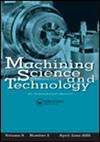不同内外流体组合对复合静电喷涂铣削性能的实验研究
IF 2.6
4区 工程技术
Q2 ENGINEERING, MANUFACTURING
引用次数: 4
摘要
摘要静电喷涂(ES)可以改善最小量润滑(MQL)的加工和环境效果。与ES相比,复合静电喷涂(CES)具有良好的充电和冷却/润滑性能,效果更好。本文从铣削力、刀具磨损和油雾浓度等方面研究了使用不同内外流体组合的CES铣削性能。本研究采用了四种内外流体组合,即水/LB2000、多壁碳纳米管(MWCNTs)-水纳米流体/LB2000,水/MWCNTs-LB2000纳米流体和MWCNTs水纳米流体/MWCNTs-LB2000纳米流体。为了分析CES铣削的性能,测量了CES的带电性能、雾化稳定性以及复合液滴的电润湿性能。结果表明,从加工和环境性能的角度来看,MWCNTs水纳米流体/LB2000是CES铣削的最佳内/外流体组合,因为纳米颗粒具有优异的充电性能、雾化稳定性和减摩效果。亮点从铣削力、刀具磨损和油雾浓度等方面研究了使用不同内外流体组合的CES铣削性能。测量了CES的充电性能、雾化稳定性以及复合液滴的电润湿性能。MWCNTs水纳米流体/LB2000是用于CES研磨的最佳内/外流体组合。本文章由计算机程序翻译,如有差异,请以英文原文为准。
Experimental investigation on the performance of composite electrostatic spraying milling using different inner/outer fluid combinations
Abstract Electrostatic spraying (ES) can improve the machining and environmental effects of minimum quantity lubrication (MQL). Compared with ES, composite electrostatic spraying (CES) presents better results because of excellent charging and cooling/lubrication performances. This article investigated the performance of CES milling using different inner/outer fluid combinations in terms of milling force, tool wear and oil mist concentration. Four inner/outer fluid combinations were employed in the study, namely, water/LB2000, multiwalled carbon nanotubes (MWCNTs)-water nanofluid/LB2000, water/MWCNTs-LB2000 nanofluid and MWCNTs-water nanofluid/MWCNTs-LB2000 nanofluid. For the analysis of the performance of CES milling, the charging property and atomization stability of CES and the electrowetting performance of composite droplet were measured. The results show that MWCNTs-water nanofluid/LB2000 was the optimal inner/outer fluid combination for CES milling from the view point of machining and environmental performances because of superior charging property, atomization stability and friction-reducing effect of nanoparticles. Highlights The performance of CES milling using different inner/outer fluid combinations was studied in terms of milling force, tool wear and oil mist concentration. The charging property and atomization stability of CES and the electrowetting performance of composite droplet were measured. MWCNTs-water nanofluid/LB2000 was the optimal inner/outer fluid combination for CES milling.
求助全文
通过发布文献求助,成功后即可免费获取论文全文。
去求助
来源期刊

Machining Science and Technology
工程技术-材料科学:综合
CiteScore
5.70
自引率
3.70%
发文量
18
审稿时长
6 months
期刊介绍:
Machining Science and Technology publishes original scientific and technical papers and review articles on topics related to traditional and nontraditional machining processes performed on all materials—metals and advanced alloys, polymers, ceramics, composites, and biomaterials.
Topics covered include:
-machining performance of all materials, including lightweight materials-
coated and special cutting tools: design and machining performance evaluation-
predictive models for machining performance and optimization, including machining dynamics-
measurement and analysis of machined surfaces-
sustainable machining: dry, near-dry, or Minimum Quantity Lubrication (MQL) and cryogenic machining processes
precision and micro/nano machining-
design and implementation of in-process sensors for monitoring and control of machining performance-
surface integrity in machining processes, including detection and characterization of machining damage-
new and advanced abrasive machining processes: design and performance analysis-
cutting fluids and special coolants/lubricants-
nontraditional and hybrid machining processes, including EDM, ECM, laser and plasma-assisted machining, waterjet and abrasive waterjet machining
 求助内容:
求助内容: 应助结果提醒方式:
应助结果提醒方式:


